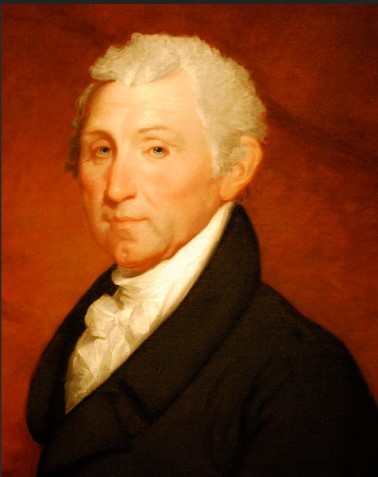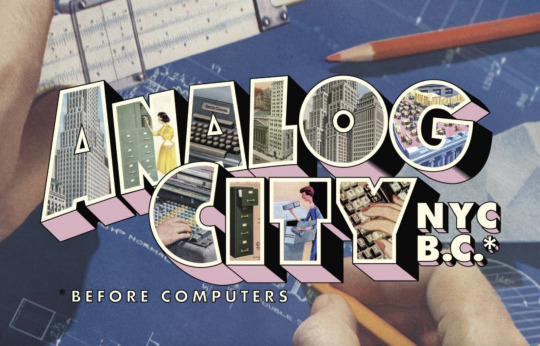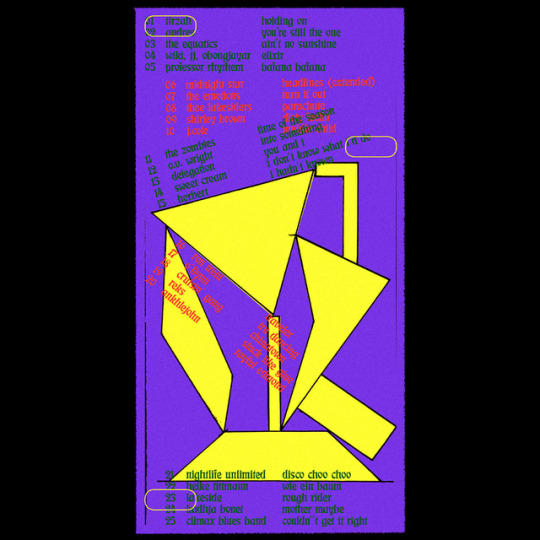#predigital
Video
Arnold makes up by Mr Flikker
Via Flickr:
Jerry Kirby's fellow singer and "girlfriend" helps a bandmate with his eye shadow.
#drag#makeup#queen#rock#soul#headdress#mirror#backstage#gay#musicians#black#San Francisco#reflection#predigital#black and white#African American#disco#1970s#'70s#seventies#[...]ษ[...]ว[...]ะ[...]#pédé#homo#Arnold Elzy#Arnold Elsie#Arnold Elsy#Arnold Elzie#LZ Love#Sylvester#backup
4 notes
·
View notes
Text
master of misdirection, predigitation and jiggery-pokery: the amazing mr fell!

19 notes
·
View notes
Photo


Cartoon: Rocky & Bullwinkle Horror Show. One of the oldest toons in my Larchives from my predigital days. I decided it was time to bring it forward :) I know others have done this joke since too. There's plenty of room to adapt it :) Enjoy! Share! Comment!
7 notes
·
View notes
Text

@ruidusborne sent: “I didn’t realize you were—y'know what, maybe we should start again. I’m Imogen.”
Encounters like this, of the odd kind seem like the norm for Lucan at this point. He has nearly lived for a century, and yet they don't cease to often be peculiar. And While he couldn't blame the woman for the confusion he had caused in her, it didn't make the high-elf any less amused. A smile briefly tugs at a corner of his mouth.
"Illusion magic does that, I suppose." he speaks in a casual tone, his making a vague gesture in the air. " It works wonders to keep certain people away." and indeed, the group of bandits that had attempted to get to him had rushed off the scene at the sight of shadow like ghosts circling them and whispering a repeated pattern in an omnious tone, loud enough for them to hear. Predigitation, you'll find, becomes more useful when combined with other things.
"and worried citizens I see. " a chuckle comes out of him following the sentence. Lucan normally preferred not to bring too much attention towards him when it came to trouble. And though he could have dealt with them some other way, they didn't seem like a big threat. Simply foolish. Besides, this method was sometimes more entertaining.
"It's good to meet you, Imogen." his smile widens ever so slightly into a grin. "I'm Lucan."
1 note
·
View note
Link
[ad_1] Like the allure of vinyl records, classic video games and even the early internet, the fascination with older photography standards like point-and-shoot cameras or 35-millimeter film persists — even in people too young to remember when that gear was cutting edge. The appeal of “vintage” photography goes beyond nostalgia and Instagram filters, judging by the huge number of apps designed to emulate the film, lenses and visual quirks of predigital photos and movies.Despite the irony of using a high-end smartphone camera to produce imperfect images that appear oversaturated, jittery, low-contrast, unfiltered or otherwise analog, going for a retro look can help you practice your composition skills. If you’re not ready to buy original equipment, you can still evoke a different time period’s creative sensibility. Here’s an overview.Getting StartedBefore you dive in, here are some things to keep in mind. First, make sure you can reverse any editing on an original image; making duplicates for your experiments is a safe backup. Second, be aware that some apps capture content with the effects embedded, leaving you with a permanently vintage-looking photo or video.You may not need extra software, depending on the visual effect you want to achieve. Apple, Google and Samsung all include a variety of filters in their default photo apps, as well as built-in editing tools. You might get satisfactory results by manually adjusting the color saturation, the tint and other elements to make the photo look as if an ancient film camera had taken it.For specific historical looks (like a 1970s Polaroid, for example), there are apps with filters and algorithms designed to emulate certain analog film stocks, camera lenses and other factors, like simulated light leaks and dust speckles. Just enter “vintage” or “retro” when you search the app store for camera or photography programs. Some apps charge for extra filters, require a subscription or have technical requirements, so read the specifications.Hipstamatic for the iPhone is one of the best-known retro camera apps — and may be considered an antique itself, as it was first released in 2009. Its original incarnation, now called Classic Camera (free to try; $2.99 with in-app purchases), is still around and uses filter combinations to mimic the look of prints taken with a cheap plastic 1980s camera. Damon Winter, a Times photographer, even used the app for a 2010 assignment in Afghanistan. Last year, the company released Hipstamatic X, an update with hundreds of filters and tools and its own online photo-sharing community (free trial; $29.99 a year to subscribe).But again, there are specialized apps. Super 16 for Android and iOS (free to try; $23.49 for a six-month subscription) has about 70 customizable filters for photos and videos and can be used to record directly — or to apply effects on existing videos.Similar software, Nexvio’s 8mm Vintage Camera app ($9.99 per year) for the iPhone, lets you record clips in the style of a black-and-white noir movie, a grainy ’70s art-house film and more.Modernize Old PhotosJust as you can make new photos look old, you can make old photos look newer — by colorizing them. If you’d like to experiment, Colorize (free trial; $18.99 a year) uses artificial intelligence to convert monochrome images, as does the Colorize Images app (free trial; $9.99 a year); both apps are available for Android and iOS.Some genealogy services — including MyHeritage and Ancestry — offer a free photo colorization tool for subscribers to use on files uploaded to the site.MyHeritage is among the commercial genealogy services that offer free photo colorization to members researching their family history.Credit...MyHeritageDepending on the original, the results may be wildly garish or — in the best-case scenario — hard to distinguish from a genuine color image. This may be considered sacrilege to historians and fans of black-and-white photography, but for projects like compiling a family tree, the modernization could make the people in the photos feel more relatable.Time-shifting images to the past or present is not for everyone, but for those who are curious, the apps are generally less expensive than trawling eBay’s used camera section or getting film developed. Just remember, light leaks and dust specks are features (and not bugs) these days. [ad_2] Source link
0 notes
Text
Looking Forwards/Looking Backwards
For the last three months now, I have basically written about nothing other than the situation in Gaza and the impact that situation is having (and continues to have) on daily life in Israel. As a result, I haven’t focused overly on the slow deterioration of things on this side of the ocean as our own nation grapples with issues that, each in its own way, could end up proving just as fateful for our nation as the effort to decimate Hamas will surely be for Israel.
It's hard to know even where to start. The shocking image of the presidents of three of America’s most prestigious institutions of higher learning all (including the Jewish one) being unable to bring themselves unequivocally to condemn calls for genocide directed against Jewish people as outside the limits of bona fide free speech on campus was bad enough. But that dismal spectacle has focused the nation’s headlights on our university campuses in general, which experience has been infinitely more upsetting. And the picture that has emerged is both terrifying and sickening: a portrait of schools, including some of our most respected institutions of higher learning, that have lost their moral compass entirely, that have descended into an Orwellian mirrorscape of reality in which traditional values are ignored, only radical extremists are granted a voice, and racism directed directly against Jewish students is considered both legitimate and, when dressed up smartly enough in anti-Israel vitriol, even virtuous. And then there is the rising tide of anti-Semitism outside the academy in all fifty states, a phenomenon that will feel eerily and deeply disconcertingly familiar to anyone possessed of even a passing acquaintanceship with Jewish history. And then, on top of all that, we are about to plunge full-bore into a presidential election in which the winner will undoubtedly be a member of a party that has room in its Congressional ranks for overt anti-Semites and/or Israel-haters. So I apologize for not writing more about our American situation lately. I do want to keep writing about Israel, but I will also try to find time to write about these United States and the future of the American enterprise as we move into 2024.
I wanted to begin writing in a positive vein, if possible even optimistically. And so I thought we might begin, in that traditional Jewish way, by looking forwards by looking backwards and focusing on a time in our nation when the citizenry was united, when respect for our leader was basically universal, and when coin of the realm was optimism, confidence in the nation’s destiny, and hope in the future. Yes, it’s been a while. But, speaking candidly, what’s two hundred years between friends?
As we exit the time machine, the president of the United States is James Monroe. Later on, he would become a high school in the Bronx (the one from which my mother graduated in 1933) and a housing project. But, in 1820, James Monroe was a man, a politician. And his story is beyond instructive.
In those days, we had Election Month rather than Election Day: in a predigital world that was also pre-electric and pre-electronic, voting took place in 1820 from November 1 to December 6. All alone on the ballot was James Monroe, the incumbent candidate of the Democratic-Republican Party. Because his was the only name on the ballot, Monroe won in all twenty-two states. It’s true that Monroe was not the first to run for president unopposed (that would have been George Washington, who ran unopposed both in 1789 and in 1793), but Monroe was the first to do so after the passage of the Twelfth Amendment to the Constitution, which set in place the rules for presidential elections that we more or less still follow. He was also the last American President to run unopposed. Can you imagine the nation fully behind its elected leader? The man didn’t come out of the blue, however.
In his own way, Monroe personally embodied the American past such as it was in 1820. He served as a soldier in the Continental Army under Washington. He studied law under Thomas Jefferson. He was a delegate to the Continental Congress that ratified the Constitution. He had been our ambassador to France and he served as governor of Virginia. Then he decided to aim higher and he ran for president in 1816 and won. And then he ran again in 1820 and this time not only won, but received every electoral vote cast but one—and that naysayer, one William Plumer, was actually a so-called “faithless elector” who defied the election results in his state of New Hampshire because he apparently wished to ensure that Washington would forever be the sole American President to be elected unanimously by the Electoral College.
So we had at the helm a leader who had won the confidence, more or less, of the entire American people. As noted, this was Monroe’s second term of office. In 1816, he beat Rufus King, the Federalist candidate, and he beat him soundly, getting more than double the votes King got. And now that he had proven himself in office, he put himself forward as candidate for a second term. No one chose to run against him. The split of the Democratic-Republican Party into the parties we know today was still in the future. The nation was at peace. And it was fully unified behind a proven leader.
At the time and since, these years were and are called the “Era of Good Feeling.” The War of 1812 had been won. The nation was prosperous and at peace. The great debate about slavery that led eventually to war had yet to begin in earnest. (Indeed, the nation had formally outlawed the slave trade in 1807 and this was widely thought of—at least by abolitionists—as a first step towards eradicating slavery totally. That that didn’t happen—and would probably never have happened other than in the way it did happen—was, of course, unknown to American voters at the time.) There seemed to be endless possibilities for expansion to the West.
I first became interested in this stretch of American history several years ago when I read Daniel Walker Howe’s masterful What Hath God Wrought: The Transformation of America 1815–1848, for which the author won the Pulitzer Prize in History. It’s a doorstopper of a book, coming in at just over 900 pages. But it is truly fascinating, a work of history distinguished (this is so rare) both by its author’s mastery of his subject and also by his great skill as an engaging author able to keep readers’ interest as they wade through material that the author surely understood would be unfamiliar to most. He paints a complex picture of a nation in its adolescence, one reminiscent in many ways of the nation today but with the huge difference that the native optimism that once characterized American culture was in its fullest flower in the 1820s. The belief that the Revolution had not solely ended with an independent United States, but had actually transformed the world by demonstrating the possibility of living free, of citizens living lives unencumbered by the will of despots and fully able to chart their own course into the future by using their own hands to wield their own tools, thus to fashion their own destiny—that distillation of the American ethos as freedom resting on a bedrock of decency, morality, and purposefulness was enough to bring the entire nation to support the man who, in the minds of all, served as the physical embodiment of that ideal. And that is how James Monroe came to run unopposed and to be elected by the entire electorate speaking as one.
How bizarre that all sounds now! Most people in the throes of crochety old age tend to idealize their adolescent years. Nations do that too. But there’s more to that thought than pathos alone. The hallmark of adolescence is fantasy unencumbered by restrictive reality—and that is true of nations as well as individuals. Nobody told the citizenry in the 1820s that they were “just” dreamers, that it could never work out as planned. And, yes, they were blind to many social issues that we now find it hard to believe they passed so blithely by—the slavery issue first and foremost, but also the harsh and terrible treatment of native Indian peoples, the degree to which women were denied a place in public life, the restrictive higher educational system to which only white males (and, generally speaking, only wealthy ones at that) were admitted. Yes, that’s all true. But the nation was also possessed of a deep, abiding sense of its own destiny. And, in the end, that’s what mattered.
It didn’t last. The nation grew up. The forced dislocation of countless thousands of native Indians from the lands they had farmed and occupied for centuries, the ongoing nightmare of slavery, the inability of the nation to keep from splitting in two and the unimaginable amount of blood that was spilt to put it back together—the resolution of all those issues was in the future when James Monroe was in the White House. And the foundation upon which his administration rested—the good feelings of the so-called “Age of Good Feelings”—was sturdy enough to support the weight of a nation.
As we embark on the 2024 Presidential election, this all seems so far away, so foreign, so unattainable. Maybe it is. Or maybe the right national leader, ideally one who has waded through Daniel Walker Howe’s giant book, is waiting in the wings to rescue us from ourselves. I suppose we’ll all find out soon enough!

1 note
·
View note
Text
the idea that black and white photography is used to make historical events feel less recent than they are is pure conjecture and the idea that it this is happening as a coordinated effort is outright conspiracy btw.
a comparison of the cost of black and white film & reproductions compared to their color counterparts makes one choice overwhelmingly more economical than the other, for one.
also, black and white film can produce higher quality images. the difference was dramatic, historically. despite incredible advancement in color film, this remains true even today (or, at least, it is true that b&w captures a wider ranger of light values, which is one metric of quality), although the difference has largely been rendered moot with the advent of cheap digital photography... the emergence of which you'll notice coincides with the growing prevalence of colored images in mass produced media.
and this is just for capturing images! the ability to reproduce images on paper en masse has been radically transformed with digital film and advancements in printing technology. of course, the paper is also now entirely optional, with purely digital media representing a possibility for image distribution on a scale that eclipses predigital film-based image distribution many thousands of times over.
not to lazily gesture to occam's razor all the time, but it solves like 99% of problems. i'm not putting this on that post but those tags gave me major second hand embarrassment.
#a major appeal of natgeo was#for many years#the high quality color photography.#it was wildly expensive and STILL produced lower quality images than b&w.#this with no expense spared equipment and no expense spared photographers
1 note
·
View note
Text
UPSC Civil Services Exams Preparation Tips from Toppers
Every year the Union Public Service Commission conducts civil services examinations for recruitment to various civil services such as the IAS, IFS, and IPS. Qualifying for the exams results in highly prestigious positions under the Government of India. Out of the several lakhs of students attempting the exams in the end less than a thousand are granted jobs. With a success rate of less than 1%, it is highly helpful for UPSC aspirants to understand what the toppers did right and what is their success mantra.
Numerous nationally trusted sources of study material for the UPSC civil services exam publish interviews and tips for success from toppers of each year. Preparatory books like “Predigital Darpan” and online platforms like “reader buzz” offer exclusive interviews of toppers where they describe their strategy for the exam and their advice for future aspirants.
Here are some preparatory tips from toppers for UPSC civil services exam:
- There is no shortcut to success. Concentration and deep study of the subjects are necessary for successfully solving problems related to them.
- Start early and give your exam preparations at least a year of devoted time. The UPSC exams have a giant syllabus covering a vast range of subjects. Don’t hurry and acquire a comprehensive understanding of the subjects over time.
- Students are offered numerous optional subjects for two papers in the Mains exam. Recognize your interests and choose your optional subjects wisely. Preparing a subject and giving up on it halfway will not only waste your time but also demotivate you. Go through the syllabi of each subject and read more about them so that you can choose according to your past academic background in the subject and your level of ease in understanding the study material.
- Make it your habit to write down notes. The notes not only simplify the revision process but they also help you recall the topics for a longer period of time. It is a scientific fact that we tend to remember things that we have written down more easily and effectively. Add diagrams, flow charts, etc. into your notes and answers in the exam.
- Practice writing down detailed answers using correct grammar in a neat, simple, and readable manner. Keep your answers compact and add flowcharts, Venn diagrams, diagrams, etc. to reflect a clear understanding of the subject material.
- You must always refer to authentic resources like referred standard NCERT textbooks and magazines like, AIR News analysis, Planning Commission Document, Economic Survey Report, and Publication Division Books.
- To be successful you must answer almost every question and for that, you need time management. Practice mock tests and learn to utilize your time effectively over the different sections of the exam. If stuck leave the question instead of panicking and wasting time on one question.
Read newspapers regularly and subscribe to recognised preparatory books and websites for valid updated information and knowledge of current affairs. To get updated information related to the upcoming exam dates, current affairs, and other such relevant topics visit the website. You can also visit here for sample essays and personality development tips.
Read the full article
0 notes
Quote
Digital communication and social media have taken over our lives. In this contrarian reflection on digitized life, Byung-Chul Han counters the cheerleaders for Twitter revolutions and Facebook activism by arguing that digital communication is in fact responsible for the disintegration of community and public space and is slowly eroding any possibility for real political action and meaningful political discourse. In the predigital, analog era, by the time an angry letter to the editor had been composed, mailed, and received, the immediate agitation had passed. Today, digital communication enables instantaneous, impulsive reaction, meant to express and stir up outrage on the spot. “The shitstorm,” writes Han, ”represents an authentic phenomenon of digital communication.”
Meanwhile, the public, the senders and receivers of these communications have become a digital swarm—not a mass, or a crowd, or Negri and Hardt's antiquated notion of a “multitude,” but a set of isolated individuals incapable of forming a “we,” incapable of calling dominant power relations into question, incapable of formulating a future because of an obsession with the present. The digital swarm is a fragmented entity that can focus on individual persons only in order to make them an object of scandal.
Han, one of the most widely read philosophers in Europe today, describes a society in which information has overrun thought, in which the same algorithms are employed by Facebook, the stock market, and the intelligence services. Democracy is under threat because digital communication has made freedom and control indistinguishable. Big Brother has been succeeded by Big Data.
In the Swarm
0 notes
Photo


OBLIQUE MAPS.....from: Atlas of Oblique Maps - download the atlas here: https://pubs.er.usgs.gov/publication/i1799
predigital maps from 1961 to 1986 representing complex geographic and topographic features
https://www.hiddenhydrology.org/atlas-of-oblique-maps/
_ik
1 note
·
View note
Text
Whatever when I wake up tomorrow it will probably seem unserious I feel like even in preindustrial predigital society there was removal from reality in elements of culture and other forms of expression..this plane of existence has been strange from time-_-
0 notes
Text
Banking Service Chronicle
banking service chronicle Published this article page no 04 Vulnerable to misuse Digitalization also bears the risk of deepening existing inequalities or being misused to undermine democracies spread dangerous misinformation and fuel discrimination xenophobia and racism. Rising inequalitiesDigital technology can also worsen economic and other inequalities. In 2019 close to 87 per cent of individuals in developed countries used the Internet compared with only 19 per cent in the least developed countries. Privacy issueDataintensive technologies contribute to creating a digital environment to track analyze predict and even manipulate people’s behavior to an unprecedented degree thereby posing significant risks for human dignity autonomy and privacy. Digitally facilitated repressionAuthoritarian governments now have enhanced capacities to censor expression block or filter access to information monitor online activity and control populations than they did in the predigital world banking service chronicle monthly magazine buy.
Banking Service Chronicle
1 note
·
View note
Text
Museum of the City of New York transports visitors to pre-digital New York in Analog City: New York B.C. (Before Computers)
Museum of the City of New York transports visitors to pre-digital New York in Analog City: New York B.C. (Before Computers)
From telephone operators to card catalogs, pneumatic tubes to drafting tables, exhibition highlights New York’s early innovations and ingenuity
A new exhibition at Museum of the City of New York takes visitors on a visit to predigital New York, where analog innovations, professions, and industries fueled the city’s growth and status. On view from May 20, 2022-December 31, 2022, Analog City: New…

View On WordPress
0 notes
Photo

This is a #inktober #latepost playing off the word "enchanted." This is actually part of a series. I started a #bigfoot last year but never posted it. So it's going to look killer digital! • • • • • #sasquatch #illustration @jakeparker @inktober #linedrawing #doodle #wip #pendrawing #blackandwhite #doodle #graphicsbyte #trees #oregon #madeinoregon #handmade #predigital #inktober2019 #enchanted #forest (at Oregon City Golf Club) https://www.instagram.com/p/B3fck48lStC/?igshid=1hfjdk4kt0195
#inktober#latepost#bigfoot#sasquatch#illustration#linedrawing#doodle#wip#pendrawing#blackandwhite#graphicsbyte#trees#oregon#madeinoregon#handmade#predigital#inktober2019#enchanted#forest
3 notes
·
View notes
Photo




Lil Artwork for Pt.3 of my more or less monthly playlist, straight outta Milano! 💜 Includes some Funk, Soul, Disco & Rap
#typography#typedesign#predigital#eckmann#shapes#illustration#graphicdesign#playlist#djschpotify#purpleandgreen#milanosounds#F39a#dolcevita#lebenliebegrafik
4 notes
·
View notes
Video
Throwback Thursday !
Been finding old artwork and animation from my early days as an animator at Disney! One of my first scenes as an animator. So long ago! This scene had a 15 foot panning background. I remember sitting there with it spread out in the hallway trying to recalculate the pegs so that I could animate this as a cycle and not across the 15 feet as it was originally laid out.
#animator#samanthayoussef#handdrawn#animation#disney#2danimation#drawing#throwbackthursday#artwork#oldschool#disneydays#disneyanimator#tarzan#disneyanimators#predigital#2d#samanthasketches#disneyanimation#roughanimation
3 notes
·
View notes